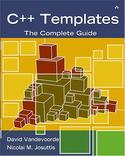

Boston, Pearson Education, Inc., 2003
ISBN: 0-201-73484-2
$54.99 US (hardcover)
This book is a user's manual for the future of C++ programming. C++ is going through a dramatic metamorphosis, moving far away from C-like pointer manipulation. With the introduction of the standard template library (STL), part of the C++ standard library, low-level coding for data structures and containers is no longer necessary. Instead, efficient generic tools already are available for your code.
One important construct underlying all the changes in C++ is templates, which introduce parameterized types for functions. This new book opens the door to understanding how templates work, with examples throughout.
Part I introduces template basics in seven chapters that extol the virtues of static polymorphism, which allows compile-time type checking that would not be possible at runtime. The authors explain the differences between function templates and class templates, how to use nontype parameters in templates and how to avoid numerous problem areas.
Part II explains templates in-depth and provides information about various kinds of arguments in template code, friend functions, the importance and control of names and how instantiation is done. It also covers how template arguments are deduced and how to decide between generic and specialized code.
The drama really unfolds in Part III. You even may catch yourself thinking, “Whoa, this is C++? I didn't know it could do all this.” The tone is set by a discussion of dynamic vs. static polymorphism. Dynamic polymorphism is the kind generally associated with C++--inheritance with dynamic dispatch at runtime. Templates are a form of static polymorphism, and compile time only seems to be limiting. But this turns out not to be the case. For example, C++ code can be constructed to moderate the behavior of classes by using templatized traits and policy classes. And, templates can be used with inheritance for applications such as parameterized virtuality, which combines the best of two forms of polymorphism.
Metaprogramming, normally associated with Lisp is one of the most powerful uses of templates. Templates actually can be used to construct program-writing programs, or code generators. After the unveiling of capabilities in Part III, Part IV offers a reprise on advanced applications. A highlight is being able to do type classification with templates. Templates allow you to use the type algebra in C++ directly for your own applications, a key to behavioral patterns.
Templates have been used to construct several useful C++ libraries, including the vast collection at boost.org. Both authors are experienced C++ programmers and are closely associated with the C++ Standards Committee. Vandevoorde is a cofounder with of the comp.lang.c++.moderated newsgroup, and Josuttis has written extensively on C++, including The C++ Standard Library.
—Michael Baxter